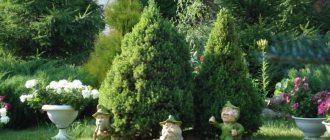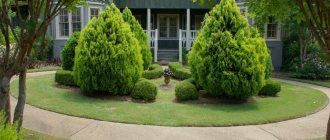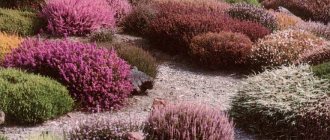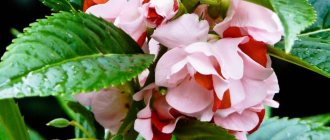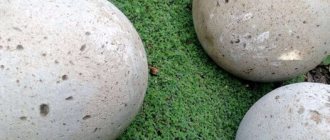Benefits of using hostas for garden decoration
Hostas (funkias) are quite popular plants that can often be found in the garden. The secret to their widespread use is this:
- Unpretentiousness in cultivation - these flowers do not require any special conditions or soil components.
- The plant is a real long-liver - it grows and blooms successfully in the country for 20 years, and sometimes more.
- It is not for nothing that Hosta is considered the queen of shade - it prefers semi-shaded or even heavily shaded places, so it can be used in almost any part of the garden.
- Greenery can have different shapes (round, heart-shaped, narrowed) and surface characteristics (smooth, wrinkled, matte, grooved, etc.), so it goes well with a wide variety of colors.
- In addition to garden design, hostas (especially their green part) are used in creating beautiful flower bouquets.
- Plant varieties are extremely diverse in stem height (some grow up to 19-20 cm, others can rise up to a meter). Thanks to this, you can create a wide variety of flower arrangements.
Important! Since hostas live and decorate the site for a very long time, gardeners initially carefully determine the place where the plant will feel most comfortable. To do this, you can plant 2-3 identical flowers in places with noticeably different conditions (shade, soil, level above the ground) and see after a year where the flowers are most bright and where the greenery grows the most.
Classification
Today there are more than 600 varieties. Based on their characteristics and features, several options for categorization into groups are used.
By type:
- glossy;
- matte;
- motley;
- with a white or green border around the edge.
According to the range of green mass:
- turning green;
- yellowing;
- whitening.
By form:
- long;
- round;
- lanceolate;
- heart-shaped;
- narrow;
- wide.
According to the height of the bush (excluding peduncle):
- miniature (dwarf) – up to 10 cm;
- small (ground cover) – 20 cm;
- medium (border) – 30 cm;
- large – 45 cm;
- giant - over 60 cm.
Related article:
DIY garden style - tips for gardeners
There is no single international standard for the parameters of each category, therefore, in different countries there are often differences between the classification of species into one group or another.
Choosing a location and optimal growing conditions
Choosing a place for a flower is very important, because it is supposed to be planted not for 1 season, but for a long time. It is better to take care of growing conditions in advance, taking into account the following rules:
- Different varieties of the “queen of shadows” have a common property: they love shaded conditions with inconsistent sunlight. Therefore, their flower beds are often located near garden trees or outbuildings. The fact is that if you plant flowers in an open area, then strong sun can have a bad effect on the coloring of the greenery - over time it will become paler, and burns may also appear.
- Hostas love moisture, so it would be optimal to plant them in low-lying areas of the garden, where moisture will accumulate after heavy rains, or near artificial reservoirs. If the summer is dry, then you will need to water frequently and abundantly - flowers do not develop well on dry soils.
- Plants should only be planted in well-dug soil. Large earthen stones must be broken. If weed rhizomes are found, they should be removed.
Important! The decision to choose a location must be made taking into account the characteristics of a particular hosta variety. For example, varieties with rich green leaves like strong shade, while plants with yellow-orange shades of green prefer semi-shade. For them, the best option would be a place that is well lit in the morning and almost completely goes into shade during the day.
Photo gallery
Hostas in solitaire plantings
One of the features of the hosta, which distinguishes it from many other ornamental plants, is that it is completely self-sufficient in order to be used in individual plantings. Such plantings are also called solitary plantings. For this method of decoration, varieties with large bushes and bright greenery that contrast against the general background of the garden are suitable.
Solitaire hosta plantings can be used for the following purposes:
- planting in corners of the garden to define natural boundaries;
- seating on elevated surfaces allows you to visually make the hosta even larger, which emphasizes its flowers especially well;
- finally, an excellent option for solitary planting is semi-empty places where there are no other plants nearby; thus not only filling the void, but also highlighting the funkia flowers.
Important! When carrying out such planting, you need to prepare the soil well - it is advisable to make the area level and plant small greenery on it to create a beautiful background against which the dark foliage of the plant will contrast well.
Hosta border
Hosta is distinguished by its stable decor. Therefore, it is often planted on both sides along paths and paths on the site. But you shouldn’t expect that the effect of the invented design will be obtained immediately after landing. You will have to wait until the plant reaches the desired size. For this design, it is recommended to plant hostas of the same variety. To prevent the plant from growing too large and looking miniature in the path area, it is necessary to use varieties up to 15 cm high. Blue Mouse Ears is considered one of these.
Furniture styles - ideas for fans of Provence, hi-tech and classic styles (107 photos)
Options for using hosts in landscape design
The variety of varieties allows them to be successfully integrated into gardens with a wide variety of designs. You can use flowers to create classic flower beds, plant them in combination with other plants, or create entire multi-tiered compositions that well organize the interior space of the site. Everything mainly depends on the gardener's ideas. In this case, the height of the plant is of great importance - large ones are often planted singly, and small ones serve as the basis of a flower arrangement. Here are just some design moves that can be used when planting hostas:
- Planting small bushy hostas (no more than 20-25 cm in height) in a continuous strip is well suited for emphasizing slopes, in the corners of the garden, as well as for rockeries (small rocky flower beds of various shapes). Such low species are also called ground covers - they perfectly hide the soil and create the effect of a green root. Also, in the shade of their thick leaves, some weeds die from lack of light
- Varieties with a height of 28-30 cm are well suited for creating green borders. They can be planted both around the perimeter of the garden and on the internal borders that separate one group of flowering plants from others.
- Hostas with an average stem height (up to half a meter) are often used to create compositions with other varieties or other crops. They highlight tall and medium-sized plants well (especially lilies and gladioli).
- Taller plants (from half a meter to 60-70 cm) are often used for planting along ponds and garden paths. They create a framing effect that visually highlights the paths. They also form a background for taller flowers.
- The tallest hostas are used in solitaire plantings, as discussed above. They also fit harmoniously into rock gardens - among the large stones, the image of a large branched tree growing in the mountains is created. In addition, against the background of light stones, the plant contrasts well due to its dark greenery.
- A hosta flowerbed can be created from plants that are uniform in height, or from plants that are different. The latter option is often more interesting, since you can create a multi-tiered composition with a gradual increase in height from the edges to the center. This allows you to feel the effect of movement and organize the space of the flowerbed on which you can plant other flowers.
Kinds
About 40 species are known, each of them is characterized by high decorativeness and ease of care. There are both shade-tolerant and those that grow in sunny areas. Below, in alphabetical order, is a description of the most popular of them.
White-edged
It got its name due to the presence of a white border; the center is painted in a rich green tone. Medium height, up to 70 cm in diameter. One of the most hardy and unpretentious.
Bloated
Large heart-shaped leaves with a dark green matte leaf are noted. The root system is located superficially. The flowers are lilac or violet.
Related article:
Flowerpots: DIY outdoor concrete decor
Wavy
Originally from Japan, one of the most common in the regions of the Russian Federation. The leaves are smaller than those of other representatives of the genus, pointed. They are distinguished by a white stripe in the middle. Height reaches 30 cm.
Siebold
One of the most beautiful, distinguished by large gray-green plates (size 40*25 cm) in the shape of an oval with a point and a coating. The flowers are lilac in color, arranged in a brush.
Curly
Neat bushes with a white edge, slightly wavy around the perimeter. The flowers are purple, located on tall stems.
Lanceolate (narrow)
Characterized by lush large plates (up to 15-17 cm in length) on high petioles. The rosette is basal, wide. Funnel-shaped flowers are collected in a brush and placed on long (up to 50 cm) smooth stems-peduncles. Flowering occurs in July.
Related article:
A hedge with fresh berries and fruits in your garden: tips for gardeners
Small
Miniature dwarf, up to 15 cm tall. Leaves are elongated and neat. The flowers are purple.
Podorozhnovaya
One of the most interesting and beautifully flowering species. Massive, with distinctive characteristic “ribs” throughout the plate. Large lily flowers bloom on tall peduncles (up to 70 cm). There is a subtle pleasant aroma and long flowering until August-September.
The smell and sweet juice on the flower stalks can attract ants and black aphids.
Erectifolia
Distribution area: Far East. Characteristic are small, erect, upward-pointing bushes.
Fortune
Compact, dense, heart-shaped, light purple flowers. It goes well with others, shading off brighter or more variegated ones.
Fortune Patriot
Ovoid
It grows up to 40 cm in height. Clusters of small flowers bloom in July-August.
What hosta goes with: choosing plant companions
Along with many of the advantages discussed, the hosta has one more: it does not compete with other plants and gets along well with most of them. The only exceptions are those who love an abundance of light. For example, roses require a lot of sun, and hostas, as already mentioned, prefer partial shade or even strong shade, so they are not grown together.
Among other colors, funkia goes well with the following:
- ferns;
- conifers;
- geraniums;
- lungwort;
- primrose;
- digitalis;
- Horny goat weed;
- astilbe;
- gladioli.
It can not only highlight their bright flowers, but also show their beautiful sides due to the contrast of greenery (for example, against the backdrop of bright green ferns).
Compositions from hostas and other plants
When creating compositions, it is important to take into account not only the design of the future flower bed, but also the matching growing conditions (abundance of moisture and shelter from direct sunlight)
Flowerbeds with heucheras and hostas
The composition of hosta with heuchera is one of the most successful options of its kind. This is explained by the fact that heuchera has flowers of delicate light shades (from white to red). They stand out well thanks to the juicy, dense greenery of the funkia. When creating a composition of these crops, it is important to take into account that heuchera grows up to half a meter in height, so it can be planted in various combinations with low-growing hosta. If the choice fell on large and tall hostas (from 80 cm to a meter), then they should always be planted in the background so that the heuchera does not get lost in their bushes.
Hostas in combination with astilbes
Astilbe and hosta share a love for shade, which is why they are often used together when creating compositions. The options for their use are limited only by the gardener’s imagination. Here are just a few of them:
- Create a beautiful garden frame using alternating hostas and astilbes.
- Arranging a flower arrangement to create a border along garden paths or ponds.
- An excellent option is a circular composition around a shady garden tree, which will fill the empty space underneath it.
- Finally, such compositions are often used to frame a lawn with even greenery in bright shades.
Other flower arrangements
Hosta fits into flower beds and other types of compositions with many plants, since varieties have different stem heights.
Basically, design moves are based on 2 ideas:
- Contrasting bright colors against the background of dark green hostas - gladioli, lilies, irises, delphiniums. The plant also contrasts well against the background of soft green foliage (small lawn vegetation, ferns).
- Creating multi-tiered compositions with height differences due to hostas and other plants. For example, the same gladioli can be placed in the background, and small varieties of hosta can be grown right in front of them. This will create the effect of upward movement due to the tiering and shape of the gladioli flowers.
Functionia can be used in a variety of ways, since there are many types of plants, and each of them has its own characteristics. At the same time, caring for the plant will not be difficult, so hosta is the choice of many gardeners, both among amateurs and professionals.
Short description
The first name is funkia. Native to Japan and Southeast Asia. It belongs to the herbaceous bush plants, has a superficial root system.
The leaves grow on tall petioles from a basal rosette. Each species is characterized by its unique color and shape of green mass.
Related article:
Why does the lawn turn yellow and dry out?
Flowers - bells or funnels - are placed on high stalks, depending on the variety, their height can reach up to 1 m. Many varieties have a delicate aroma. The main color options are white, purple and lilac. Flowering begins in July-August and can continue until October. Even after its completion, high decorativeness is noted.
Most often, propagation is practiced by dividing bushes that have reached the age of 6-8 years into parts. Since active growth of the rosette begins already in the first year after planting, such cuttings are planted at a distance of about 30-50 cm from each other.
Growing hosta in a flowerbed is not at all difficult: it is known for its undemanding nature in sunlight, which makes it possible to plant it even in the shady parts of the garden or plot. It is characterized by high frost resistance - it can withstand winter even without additional shelter.
Related article:
Perennial flowerbed: beauty for a long time without much hassle
To add splendor, periodic fertilizing with organic fertilizers, superphosphate and nitrogen-containing preparations is carried out.
Refers to plants with a long life period. It can grow without transplanting in the same place for 10 years. The total duration of growth is about 25 years.
It is widely used in landscape design when decorating borders, in single or group plantings.


